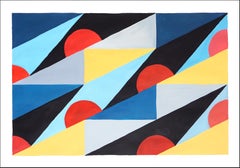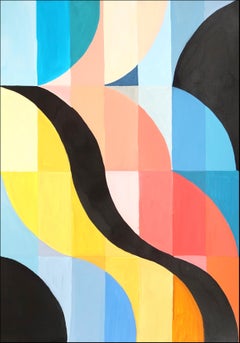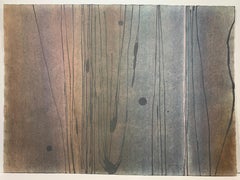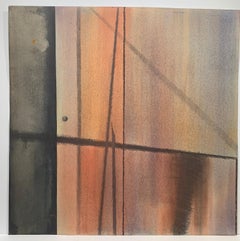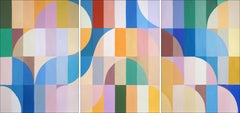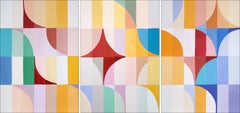Neo-Constructivist Abstract Paintings
to
1
2
Overall Width
to
Overall Height
to
2
38,071
11,211
1,646
1,588
773
555
493
367
336
285
145
62
21
5
1
1
2
2
1
1
1
2
2
Style: Neo-Constructivist
Geometric Bauhaus, Red and Black Art Deco Beach Tiles Painting on Paper 2024
Located in Barcelona, ES
These series of paintings by Natalia Roman gather their inspiration from geometric, minimalist shapes and paintings from the beginning of Modernism, with a special emphasis on Art Deco shapes of the 30's, 40's and 50's. The subtle but chic color combinations will combine beautifully with both vintage and modern furniture without overtaking spaces that are carefully crafted by designers.
Natalia Roman was born in 1984 in Girona, Spain. She has exhibited in galleries across Europe and her colorful, abstract paintings are part of private collections all over the world.
Details:
Title: Art Deco Beach...
Category
2010s Neo-Constructivist Abstract Paintings
Materials
Watercolor, Handmade Paper
Waves and their Shadows, Bauhaus Geometric Patterns in Black, Primary Tones Hue
Located in Barcelona, ES
This abstract geometric acrylic painting is a vibrant and playful composition that draws inspiration from vintage Italian parasols. With a focus on bold, bright colors and clean line...
Category
2010s Neo-Constructivist Abstract Paintings
Materials
Oil, Rag Paper
Related Items
#135 (Abstract Expressionist painting)
Located in Wilton Manors, FL
Douglas M. Olsen (b. 1960). #135, 1982. Watercolor on rag paper, 22 x 30 inches. Signed lower margin and on verso.
Category
20th Century Neo-Constructivist Abstract Paintings
Materials
Watercolor, Rag Paper
#38 After the Rains
Located in Wilton Manors, FL
Douglas M. Olsen (b. 1960). #38, After the Rains, 1980. Watercolor on rag paper, 22 x 22 inches. Signed lower margin and on verso.
Category
20th Century Neo-Constructivist Abstract Paintings
Materials
Watercolor, Rag Paper
Figure Sur Rouge (Figure on Red) /// Contemporary French Painting Minimalism Art
Located in Saint Augustine, FL
Artist: Pierre Marie Brisson (French, 1955-)
Title: "Figure Sur Rouge (Figure on Red)"
*Signed by Brisson lower right. It is also signed and dated on verso
Year: 1983
Medium: Origina...
Category
1980s Neo-Constructivist Abstract Paintings
Materials
Mixed Media, Rag Paper, Handmade Paper, Oil, Paint
$1,200 Sale Price
70% Off
H 25.75 in W 20.13 in
Fishing Boat in Storm (double-sided)
Located in Wilton Manors, FL
James Floyd Clymer (1893-1982), ca.1930. Watercolor and pencil on paper measures 15 x 20 inches. Signed lower margin.
Tape residue marks on back. Glue marks at bottom left and ri...
Category
Early 20th Century Neo-Constructivist Abstract Paintings
Materials
Watercolor, Rag Paper, Pencil
Newfoundland Landscape (Canada)
Located in Wilton Manors, FL
Beautiful abstract painting by American artist, James Floyd Clymer (1893-1982). Newfoundland, ca.1930. Watercolor and pencil on paper measures 14 x 20 inches. Signed lower margin.
James Floyd Clymer ( 1893-1982 ) known for his Regionalist style of land, sea and cityscapes, created paintings with an emphasis on color and form. His works possess a clear and simple style, easily understood by the masses.
Born in Perkasie Pennsylvania, 20 miles north of Philadelphia, Clymer was the
youngest of seven children. Losing his mother during childbirth, he was raised by his eldest sister. He attended Drexel University in Philadelphia, studying Art and Architecture and worked as an Architect in the years following World War I.
During this time, Clymer met the artist Gwenyth Waugh, daughter of the renowned marine painter, Frederick Judd Waugh. His thrust then changed from Architect to Artist. Together, the couple travelled to destinations such as Spain and Newfoundland, where they gave birth to their only daughter.
In the early 1920's, Clymer and family settled in Provincetown, MA and quickly became associated with notable artists such as Helen Sawyer, Edwin Dickinson...
Category
Early 20th Century Neo-Constructivist Abstract Paintings
Materials
Watercolor, Rag Paper, Pencil
Newfoundland Landscape (Canada)
Located in Wilton Manors, FL
Beautiful lanscape painting by American artist, James Floyd Clymer (1893-1982). Newfoundland, ca.1930. Watercolor and pencil on paper measures 14 x 20 inches. Signed lower margin.
SHIPS ROLLED.
James Floyd Clymer ( 1893-1982 ) known for his Regionalist style of land, sea and cityscapes, created paintings with an emphasis on color and form. His works possess a clear and simple style, easily understood by the masses.
Born in Perkasie Pennsylvania, 20 miles north of Philadelphia, Clymer was the
youngest of seven children. Losing his mother during childbirth, he was raised by his eldest sister. He attended Drexel University in Philadelphia, studying Art and Architecture and worked as an Architect in the years following World War I.
During this time, Clymer met the artist Gwenyth Waugh, daughter of the renowned marine painter, Frederick Judd Waugh. His thrust then changed from Architect to Artist. Together, the couple travelled to destinations such as Spain and Newfoundland, where they gave birth to their only daughter.
In the early 1920's, Clymer and family settled in Provincetown, MA and quickly became associated with notable artists such as Helen Sawyer...
Category
Early 20th Century Neo-Constructivist Abstract Paintings
Materials
Watercolor, Rag Paper, Pencil
The Battle, Luminism, oil, pigment on archival paper
Located in Booklyn, NY
It is only after we emerged from the horrible Pandemic, that we realized what a battle it was for simple daily living. Tom created The Battle a few years into the Pandemic.
The pict...
Category
2010s Neo-Constructivist Abstract Paintings
Materials
Oil, Rag Paper, Pigment
$3,500
H 26 in W 33.5 in D 1.5 in
Composition in Red / oil and metal leaf
Located in Burlingame, CA
Composition in Red - Framed. French American Frédéric Choisel is inspired by the cities of France, New York and the Bay Area and creates elegant abstractions that tell a story of urb...
Category
21st Century and Contemporary Neo-Constructivist Abstract Paintings
Materials
Gold Leaf
Bone Stroke Permutations
Located in Vancouver, CA
Mullvihill's work is comprised of Chinese characters written in four directions, creating a mandala effect. His Calligraffiti, employing 'Cut-Up' and 'Permutation' processes, results...
Category
2010s Neo-Constructivist Abstract Paintings
Materials
Watercolor, Handmade Paper
Intersecting Magic Square
Located in New York, NY
Charmion von Wiegand
Intersecting Magic Square, ca. 1963
Gouache on paperboard
Signed and titled on the back of the artwork. The signature shown on the frame back is a photo of the actual signature on the artwork itself.
Frame Included: elegantly floated and framed in hand made white wood museum frame with UV plexiglass
This work is signed and titled on the back of the artwork itself. The signature shown on the back of the frame is a photo of the actual signature, since the actual pencil signature and title is on the artwork itself, which can't be seen within the frame
Measurements:
Frame:
21 x 17 x 1.5 inches
Artwork:
18 x 14.25 inches
The Estate of the celebrated artist Charmion Von Wiegand has been represented exclusively by Michael Rosenfeld...
Category
1960s Neo-Constructivist Abstract Paintings
Materials
Gouache, Handmade Paper, Mixed Media, Pencil
British Abstraction oil on paperboard Alec Cumming Temple Red Orange Black
Located in Norfolk, GB
Artist: Alec Cumming
Title: To the Sound of the Temple
Medium: oil on paper
Size: 97 x 63 cm (38 x 25")
Year: 2016
Alec Cumming
Exhibited at Alec Cummin...
Category
2010s Neo-Constructivist Abstract Paintings
Materials
Oil, Rag Paper
$872
H 38.19 in W 24.81 in
North on West Street (West Side Highway NYC Cityscape)
Located in Wilton Manors, FL
De Hirsh Margules (1899-1965). North on West Street , 1939. Watercolor on Arches wove paper. Signed and dated in pencil by artist lower margin. Sheet measures 15 x 22 inches. Framed measurement: 27 x 34 inched. Incredibly vibrant and saturated color with no fading or toning of sheet.
Provenance: Babcock Galleries, NYC
De Hirsh Margules (1899–1965) was a Romanian-American "abstract realist" painter who crossed paths with many major American artistic and intellectual figures of the first half of the 20th century. Elaine de Kooning said that he was "[w]idely recognized as one of the most gifted and erudite watercolorists in the country". The New York Times critic Howard Devree stated in 1938 that "Margules uses color in a breath-taking manner. A keen observer, he eliminates scrupulously without distortion of his material." Devree later called Margules "one of our most daring experimentalists in the medium"
Margules was also a well-known participant in the bohemian culture of New York City's Greenwich Village, where he was widely known as the "Baron" of Greenwich Village.[1] The New York Times described him as "one of Greenwich Village's best-known personalities" and "one of the best known and most buoyant characters about Greenwich Village.
Early Life
De Hirsh Margules was born in 1899 in the Romanian city of Iași (also known as Iasse, Jassy, or Jasse). When Margules was 10 weeks old, his family immigrated to New York City. Both of his parents were active in the Yiddish theater, His father was Yekutiel "Edward" Margules, a "renowned Jewish actor-impresario and founder of the Yiddish stage." Margules' mother, Rosa, thirty-nine years younger than his father, was an actress in the Yiddish theater and later in vaudeville. Although Margules appeared as a child actor with the Adler Family[11] and Bertha Kalich, his sister, Annette Margules, somewhat dubiously continued in family theater and vaudeville tradition, creating the blackface role of the lightly-clad Tondelayo (a part later played on film Hedy Lamarr) in Earl Carroll's 1924 Broadway exoticist hit, White Cargo. Annette herself faced stereotyping as an exotic flower: writing about her publicist Charles Bouchert stated that "Romania produces a stormy, temperamental type of woman---a type admirably fitted to portray emotion." His brother Samuel became a noted magician who appeared under the name "Rami-Sami." Samuel later became a lawyer, representing magician Horace Goldin, among others. A family portrait including a young De Hirsh, a portrait of Rosa and Annette together, and individual photos of Rosa and Edward can be found on the Museum of the City of New York website.
At around age 9 or 10, Margules took art classes with the Boys Club on East Tenth Street, and his first taste of exhibition was at a student art show presented by the club. By age 11, he had won a city-wide prize (a box camera) at a children's art show presented by the department store Wanamakers.
As a young teenager, Margules was already displaying a characteristic kindness and loyalty. Upon hearing that two friends (one of them was author Alexander King), were in trouble for breaking a school microscope, the nearly broke Margules gave them five dollars to repair the microscope . Margules had to approach a wealthy man that Margules had once saved on the subway from a heart attack. Margules didn't reveal the source of the five dollars to King until twenty-five years later.
In his late teens, Margules studied for a couple of months in Pittsburgh with Edwin Randby, a follower of Western painter Frederic Remington. Thereafter he pursued a two-year course of studies in architecture, design and decoration at the New York Evening School of Art and Design, while working as a clerk during the day at Stern's Department Store. He was encouraged in these artistic pursuits by his neighbor, the painter Benno Greenstein (who later went by the name of Benjamin Benno).
Artistic career
In 1922, Margules began work as a police reporter for the City News Association of New York .Margules then considered himself something of an expert on art, and the painter Myron Lechay is said to have responded to some unsolicited analysis of his work with the remark "Since you seem to know so much about it, why don't you paint yourself?" This led to study with Lechay and a flurry of painting.
Margules' first show was in 1922 at Jane Heap's Little Review Gallery. Thereafter Margules began to participate in shows with a group including Stuart Davis, Jan Matulka, Buckminster Fuller (exhibiting depictions of his "Dymaxion house") in a gallery run by art-lover and restaurateur Romany Marie on the floor above her cafe.
Jane Heap, left, with Mina Loy and Ezra Pound
During the 1920s, Margules traveled outside of the country a number of times. In 1922, with the intent of reaching Bali, he took a job as a "'wiper on a tramp steamer where [he] played nursemaid to the engine." He reached Rotterdam before he turned back. He would return to Rotterdam shortly thereafter.
In 1927, Margules took a lengthy leave of absence from his day job as a police reporter in order to travel to Paris, where he "set up a studio in Montmartre's Place du Tertre, on the top floor of an almost deserted hotel, a shabby establishment, lacking both heat and running water." He studied at the Louvre and traveled to paint landscapes in provincial France and North Africa.
Margules also joined the "Noctambulist" movement and experimented with painting and showing his artwork in low light.Jonathan Cott wrote that:
the painter De Hirsch Margulies sat on the quays of the Seine and painted pictures in the dark. In fact, the first exhibition of these paintings, which could be seen only in a darkened room, took place in [ Walter Lowenfels'] Paris apartment.
Elaine de Kooning remarked that studying the works of the Noctambulists confirmed Margules' "direction toward the use of primary colors for perverse effects of heavy shadow."
It was also in Paris that Margules initially conceived his idea of "Time Painting", where a painting is divided into sectors, each representing a different time of day, with color choices meant to evoke that time of day.
In Paris, his social circle included Lowenfels, photographer Berenice Abbott, publisher Jane Heap, composer George Anthiel, sculptor Thelma Wood, painter André Favory, writer Norman Douglas, writer and editor George Davis, composer and writer Max Ewing, and writer Michael Fraenkel.
Upon his return to New York in 1929, Margules attended an exhibition of John Marin's paintings.
While at the exhibition, he "launched into an eloquent explanation of Marin to two nearby women", and was overheard by an impressed Alfred Stieglitz. The famous photographer and art promoter invited Margules to dine with his wife, the artist Georgia O'Keeffe, and his assistant, painter Emil Zoler. Stieglitz thereafter became a friend and mentor to Margules, becoming for him "what Socrates was to his friends."
Alfred Stieglitz
Stieglitz introduced Margules to John Marin, who quickly became the most important painterly influence upon Margules. Elaine de Kooning later noted that Margules was "indebted to Marin and through Marin to Cézanne for his initial conceptual approach - for his constructions of scenes with no negative elements, for skies that loom with the impact of mountains." Margules himself said that Marin was his "father and ... academy." The admiration was by no means unreciprocated: Marin said that Margules was "an art lover with abounding faith and sincerity, with much intelligence and quick seeing." Stieglitz also introduced Margules to many other artistic and intellectual figures in New York.
With the encouragement of Alfred Stieglitz, Margules in 1936 opened a two-room gallery at 43 West 8th Street called "Another Place." Over the following two years there were fourteen solo exhibitions by Margules and others, and the gallery was well-respected by the press. It was in this gallery that the painter James Lechay, Myron's brother, exhibited his first painting.
In 1936, Margules first saw recognition by major art museums when both the Museum of Modern Art and the Museum of Fine Arts, Boston purchased his works.
In 1942, Margules gave up working as a police reporter, and apparently dedicated himself thereafter solely to an artistic vocation.
"The Baron of Greenwich Village"[edit]
Margules made his mark not only as an artist, but also as an outsized personality known throughout Greenwich Village and beyond.
To local residents, Margules was known as the "Baron", after Baron Maurice de Hirsch, a prominent German Jewish philanthropist. Margules was easily recognizable by the beret he routinely wore over his long hair. Writer Charles Norman said that he "dressed with a flair for sloppiness."
He was said to "know everybody" in Greenwich Village, to the extent that when the novelist and poet Maxwell Bodenheim was murdered, Margules was the first one the police sought to identify the body. Margules' letters show him interacting with art world figures such as Sacha Kolin, John Marin and Alfred Stieglitz, as well as with prominent figures outside the art world such as polymath Buckminster Fuller and writer Henry Miller.
Most of his friends and acquaintances found Margules a generous and voluble man, given to broadly emotionally expressive gestures and acts of kindness and loyalty. In 1929, he exhibited an example of this loyalty and fellow-feeling when he appeared in court to fight what the wrongful commitment of his friend, writer and sculptor Alfred Dreyfuss, who appeared to have been a victim of an illicit attempt to block an inheritance.
The Greenwich Village chronicler Charles Norman described the bone-crushing hugs that Margules would routinely bestow on his friends and acquaintances, and speaks of the "persuasive theatricality" that Margules seemed to have inherited from his actor parents. Norman also wrote about Margules' routine acts of kindness, taking in homeless artists, constantly feeding his friends and providing the salvatory loan where needed. Norman also notes that Margules was blessed with a loud and good voice, and was apt to sing an operatic air without provocation.
The writer and television personality Alexander King said
I think the outstanding characteristics of my friend's personality are affirmation, emphasis, and overemphasis. He chooses to express himself predominantly in superlatives and the gestures which accompany his utterances are sometimes dangerous to life and limb. Of the bystanders, I mean.
King also spoke with affectionate amusement about Margules' pride in his cooking, speaking of how "if he should ever invite you to dinner, he may serve you a hamburger with onions, in his kitchen-living room, with such an air of gastronomic protocol, such mysterious hints and ogliing innuendoes, as if César Ritz and Brillat-Savarin had sneaked out, only a moment before, with his secret recipe in their pockets."
Margules was such a memorable New York personality that comic book writer Alvin Schwartz imagined him at the Sixth Avenue Cafeteria in a risible yet poignant debate with Clark Kent about whether Superman had the ability to stop Hitler.
Margules' entrenchment in the Greenwich Village milieu can be seen in a photograph from Fred McDarrah's "Beat Generation Album" of a January 13, 1961 writers' and poets' meeting to discuss "The Funeral of the Beat Generation", in Robert Cordier [fr]'s railroad flat at 85 Christopher Street. Among the people in the same photograph are Shel Silverstein...
Category
1930s Neo-Constructivist Abstract Paintings
Materials
Watercolor, Rag Paper
$6,000 Sale Price
20% Off
H 15 in W 22 in
Previously Available Items
Art Deco Pastel Patterns, Bauhaus Arches Triptych, Organic Patterns Blue, Yellow
Located in Barcelona, ES
This series of abstract geometric paintings by Natalia Roman draws its inspiration from the sleek grids and curves of Bauhaus architecture, while at the same time exploring bright an...
Category
2010s Neo-Constructivist Abstract Paintings
Materials
Paper, Acrylic
Red Poppy Season, Geometric Flowers in Vivid Tones, Painting Triptych, Tiles
Located in Barcelona, ES
This series of abstract geometric paintings by Natalia Roman draws its inspiration from the sleek grids and curves of Bauhaus architecture, while at the same time exploring bright an...
Category
2010s Neo-Constructivist Abstract Paintings
Materials
Paper, Acrylic
Golden Bauhaus Hourglass, Geometric Arches, Yellow, Pastel Tones Triptych, Paper
Located in Barcelona, ES
This series of abstract geometric paintings by Natalia Roman draws its inspiration from the sleek grids and curves of Bauhaus architecture, while at the same time exploring bright an...
Category
2010s Neo-Constructivist Abstract Paintings
Materials
Paper, Acrylic
Checkered Spring Sunsets, Geometric Bauhaus Landscape Triptych in Vivid Tones
Located in Barcelona, ES
This series of abstract geometric paintings by Natalia Roman draws its inspiration from the sleek grids and curves of Bauhaus architecture, while at the same time exploring bright an...
Category
2010s Neo-Constructivist Abstract Paintings
Materials
Paper, Acrylic
Cappadocia Air Balloons, Bauhaus Triptych Painting, Landscape Mosaic, Red, Paper
Located in Barcelona, ES
This series of abstract geometric paintings by Natalia Roman draws its inspiration from the sleek grids and curves of Bauhaus architecture, while at the same time exploring bright an...
Category
2010s Neo-Constructivist Abstract Paintings
Materials
Paper, Acrylic
Solar Eclipse Waves, Colorful Bauhaus Horizontal Painting Grid on Canvas, 2014
Located in Barcelona, ES
"Solar Eclipse Waves" is a painting by Spanish artist Natalia Roman. This series of abstract geometric paintings by Natalia Roman draws its inspiration from the sleek grids and curve...
Category
2010s Neo-Constructivist Abstract Paintings
Materials
Cotton Canvas, Oil, Acrylic
H 35.5 in W 47.3 in D 1.5 in
New Mexico Desert Sky, Primary Tones and Black, Geometry Astronomy Triptych
Located in Barcelona, ES
Details:
Title: New Mexico Desert Sky
Medium: Acrylic on Watercolour Paper
Size: 28x59 inches (28x20 inches, each panel), 70x150 cm (70x50 cm each panel)
Year: 2023
* Certificate of ...
Category
2010s Neo-Constructivist Abstract Paintings
Materials
Oil Pastel, Oil, Acrylic, Watercolor, Gouache
Triangular Architecture in Pastel Tones, Light Yellow Background Terrazzo Shapes
Located in Barcelona, ES
"Triangular Architecture" is a hand-painted acrylic painting on high-quality 300g paper by artist Ryan Rivadeneyra. These painting, influenced by modernist artists of the 50's, 60's...
Category
2010s Neo-Constructivist Abstract Paintings
Materials
Oil Pastel, Ink, Sumi Ink, Oil, Acrylic, Watercolor, Archival Paper
Primary Colors and Shapes on Light Yellow, Abstract Geometric Painting, Triangle
Located in Barcelona, ES
"Primary Colors on Light Yellow" is an abstract painting diptych by Spanish artist Natalia Roman. It is a beautiful combination of geometric shapes in a classy gamut of colors. The u...
Category
2010s Neo-Constructivist Abstract Paintings
Materials
India Ink, Oil, Rag Paper
Neo-constructivist abstract paintings for sale on 1stDibs.
Find a wide variety of authentic Neo-Constructivist abstract paintings available for sale on 1stDibs. Works in this style were very popular during the 21st Century and Contemporary, but contemporary artists have continued to produce works inspired by this movement. Many Pop art paintings were created by popular artists on 1stDibs, including and Natalia Roman. Frequently made by artists working with Oil Paint, and Paint and other materials, all of these pieces for sale are unique and have attracted attention over the years. Not every interior allows for large Neo-Constructivist abstract paintings, so small editions measuring 34.75 inches across are also available. Prices for abstract paintings made by famous or emerging artists can differ depending on medium, time period and other attributes. On 1stDibs, the price for these items starts at $656 and tops out at $1,295, while the average work sells for $880.
